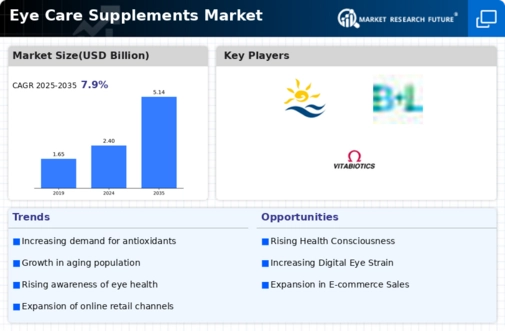Aging Population
The demographic shift towards an aging population globally seems to significantly influence the Global Eye Care Supplements Market Industry. As individuals age, they become more susceptible to various eye conditions, necessitating the use of supplements designed to support eye health. The World Health Organization indicates that by 2030, the number of people aged 60 years and older will surpass 1 billion, further emphasizing the potential market for eye care products. This demographic trend is likely to drive the market's growth, contributing to an anticipated increase to 5.14 USD Billion by 2035, as older adults seek preventive measures for maintaining their vision.
Market Growth Projections
The Global Eye Care Supplements Market Industry is poised for substantial growth, with projections indicating a rise from 2.4 USD Billion in 2024 to 5.14 USD Billion by 2035. This growth trajectory suggests a compound annual growth rate (CAGR) of 7.16% from 2025 to 2035, reflecting the increasing consumer interest in eye health and the effectiveness of supplements. The market dynamics are influenced by various factors, including demographic shifts, technological advancements, and changing consumer preferences. These projections underscore the potential for eye care supplements to become a vital component of health and wellness regimens globally.
Rising Awareness of Eye Health
The increasing awareness regarding eye health among consumers appears to be a primary driver for the Global Eye Care Supplements Market Industry. As individuals become more informed about the potential risks associated with poor eye health, such as macular degeneration and cataracts, the demand for supplements that support vision is likely to rise. Educational campaigns by health organizations and the availability of information through digital platforms contribute to this trend. This heightened awareness is expected to propel the market, which is projected to reach 2.4 USD Billion in 2024, indicating a growing recognition of the importance of maintaining eye health.
Growing Demand for Preventive Healthcare
The rising trend toward preventive healthcare seems to be a significant factor driving the Global Eye Care Supplements Market Industry. Consumers are increasingly prioritizing proactive measures to maintain their health, including eye health. This shift is reflected in the growing sales of dietary supplements that support vision, as individuals seek to prevent potential eye issues rather than address them post-occurrence. The market's growth trajectory is expected to align with this trend, as more consumers recognize the value of eye care supplements in their daily health regimens. Consequently, the market is projected to expand, reaching 5.14 USD Billion by 2035.
Increased Availability of Eye Care Supplements
The enhanced availability of eye care supplements in various retail channels appears to be a driving force behind the Global Eye Care Supplements Market Industry. With the proliferation of e-commerce platforms and health-focused retail outlets, consumers have greater access to a wide range of eye care products. This increased accessibility not only facilitates consumer purchases but also raises awareness about the benefits of eye care supplements. As a result, the market is likely to witness substantial growth, supported by the convenience of purchasing options and the variety of products available to consumers.
Technological Advancements in Supplement Formulations
Innovations in supplement formulations appear to play a crucial role in shaping the Global Eye Care Supplements Market Industry. Advances in research and technology have led to the development of more effective and bioavailable ingredients, such as lutein and zeaxanthin, which are known for their protective effects on the eyes. These advancements not only enhance the efficacy of eye care supplements but also attract consumers seeking high-quality products. As a result, the market is likely to experience robust growth, with a projected compound annual growth rate (CAGR) of 7.16% from 2025 to 2035, reflecting the increasing consumer preference for scientifically-backed formulations.







Leave a Comment